From internal pipelines, drains are transported by external ...

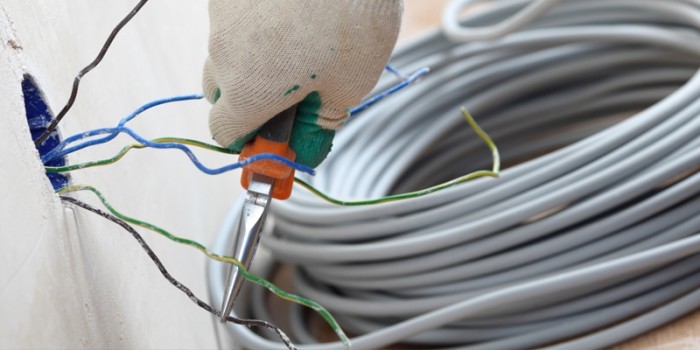

In order to calculate this indicator, it is necessary to subtract the total power of all electrical appliances (kettle, washing machine, iron, ovens, heaters, lighting devices) that can be used in the future. The power of electrical appliances can be found by examining the labels, passports, boxes and the products themselves. The resulting figure is multiplied by a factor of 1.5, or 2, to create a stock.
For convenience, the room in which the wiring is calculated can be divided into zones and calculate the cross-section of wires based on this division, for example, separately for the house, garage. This must be done as accurately as possible, since the effectiveness of the operation of the automatic shutdown will depend on this indicator. If the calculation is carried out incorrectly, the machine will either not work in emergency situations, or will turn off unnecessarily if several powerful electrical appliances are connected to the network at the same time.
The calculation of the wire cross-section must be done with a margin, and the circuit breakers must be selected as accurately as possible, so that when an emergency occurs, it works most efficiently.
After the total power indicator is calculated, it is necessary to determine the type of cable. For these purposes, you can use copper and aluminum types of cables. But at present copper is mainly used, since aluminum is more brittle and requires a larger cross section. Therefore, their use is not advisable.
For example, take the total power of all electrical appliances 10-15 kW. If we use a copper cable, then for such a load, a cross section of 6 square meters is required. mm And for aluminum - 10 square meters. mm With a load of twice as much, the cable cross section increases three times. These calculations are applicable for single phase open installation. But if it is closed, then to prevent overheating and fire, it is necessary to do the calculated figure more and a half times.
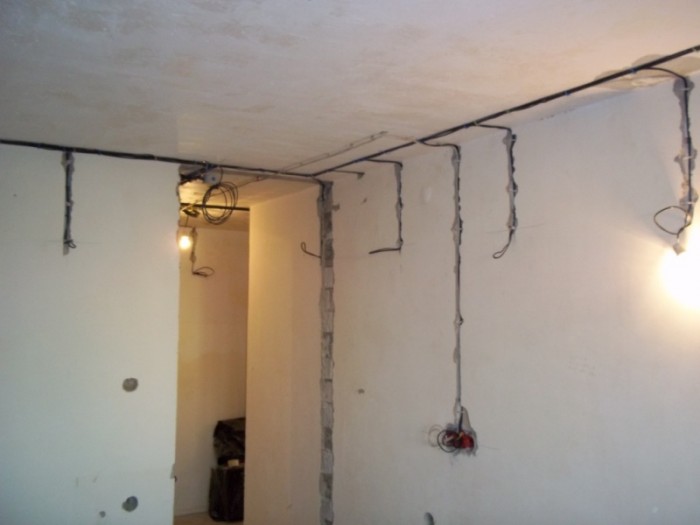
To lay the cable within the house, the following section indicators are used:
Particular attention should be paid to the kitchen, since it is there that powerful appliances are used in large quantities (washing machines, electric ovens and ovens, floor heating system). This factor should be taken into account and, possibly, a separate wiring for the most powerful electrical appliances should be done. In this case, you need to take into account such indicators:
You can determine the required cable cross-section yourself, armed with a calculator and making simple calculations, paying attention to the tables from the Rules for the operation of electrical installations. But if there is neither the desire nor the opportunity to do this yourself, then you can use the online calculator to calculate the required wire cross-section or resort to the services of professionals.
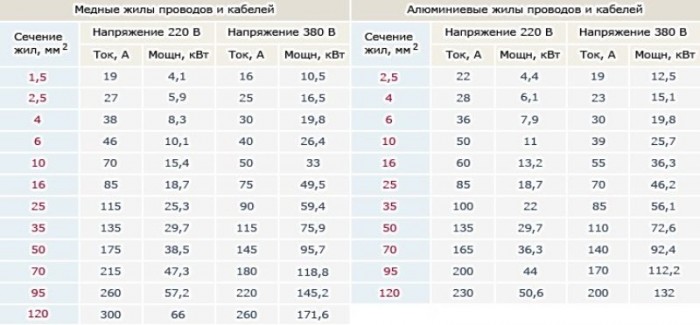
Calculation of cable cross-section by power is performed in order to ensure that the selected cable meets the requirements for reliability and safe operation of the wiring.
If you use a wire cross section that is not suitable for the given current loads, this can lead to overheating of the wire, melting of the insulation, as well as to a short circuit and, as a result of the last event, a fire. Competent choice power cable cross-sections avoids these problems.
To calculate the resistance of a conductor, you can use the calculator to calculate the resistance of a conductor.
The main indicator from which the required wire cross-section is calculated is its permissible current load. The current load is the amount of current that it can conduct through itself for a long time.
When finding the value of the rated current, calculation of the power of all electrical appliances in the house. After the power indicator is found, the current strength is calculated according to the following formulas:
Cable cross-section for power for a single-phase 220 V network:
Cable cross-section for power for a three-phase power supply network 380 V:
![]()
Permissible current loads on the wire are calculated according to the normative document GOST 31996-2012 "POWER CABLES WITH PLASTIC INSULATION".
For example, for a three-phase load of 15 kV, it is necessary to use a copper wire (laying over the air). How to calculate the necessary power cable cross-section? First, the current load is calculated based on a given power. For a three-phase cable, 2 formula is applied: I \u003d P / √3. 380 \u003d 22.8 ≈ 23 A. However, according to GOST 31996-2012, in the case when a four-core cable is used, the current value must be multiplied by a factor of 0.93. I \u003d 0.93 * 27 \u003d 25 A. From the calculations it turns out that for this case, you can take a copper wire with a cross section of 2.5 mm2 (according to GOST).
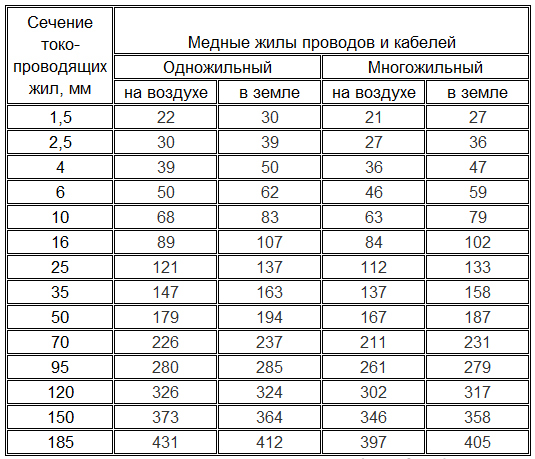
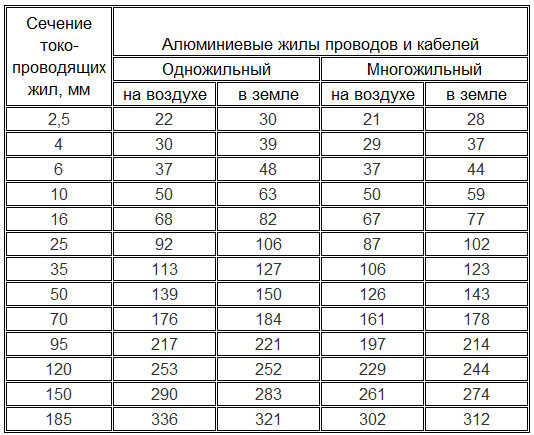
Unfortunately, many manufacturers produce cables with low power section, therefore, in this article it is recommended to take a cable with a large margin. For the case under consideration, the recommended wire cross section will be approximately 4 mm2.
It must be remembered that most fires occur due to the use of poor-quality wiring. Such products are often produced by many small enterprises in order to save on production. Because of this, it is better to give preference to those products that are produced in accordance with GOST standards by large enterprises.
Which wire is better to use for wiring copper or aluminum?
Currently, the most popular are copper wires. Such cables, in comparison with aluminum, have the following advantages:
1) copper is stronger, softer, does not break in places of excesses;
2) copper is less susceptible to corrosion and oxidation;
3) the copper wire can withstand a large current load.
The main disadvantage of copper wires is the price. On average, their cost is 3-4 times higher. Despite this, copper wires are more common and popular.
After calculating the load and determining the material (in this case, copper), we will calculate power cable cross-sections. As an example, the calculation will be carried out for a two-room apartment.
The entire load is divided into power and lighting groups. Let the outlet groups installed in the bathroom and in the kitchen have the main power load. The most powerful equipment is always installed there (electric kettle, refrigerator, washing machine, microwave, etc.).
Provided that the power load is distributed across different outlets, we use a wire with a cross section of 2.5 mm2. What does this mean? For example, in the kitchen, to connect all household appliances at the same time, you will need 3-4 outlets. If there will be only 1 outlet, then it will be necessary to use a copper cable having a cross section of 5-6 mm2.
In residential premises, 1.5 mm2 wire can be used to power outlets. However, the final choice must be made after making the necessary calculations.
To power the lighting load, you can use a cable with a cross section of 1.5 mm2.
You need to understand that the current power in different sections of the wiring will be different. The largest load falls on the opening to the apartment plot. This is due to the fact that the entire load passes through it. The recommended cross section of the input supply wire is 4-6 mm2.
When installing home electrical wiring, cables and wires of the PVS, VVG, PPV, APPV brands are most often used.
The most common brands of wires and cables:
PPV - a flat copper cable with a single insulation, for which wires with two or three conductors are used. This cable is used for laying hidden or fixed wiring;
APPV - a flat aluminum cable with single insulation, for which wires with two or three conductors are used. This cable is used for laying hidden or fixed wiring;
PVA - a round copper cable with double insulation, having from three to five cores in a wire. Used for laying open or hidden wiring;
ШВВП - a round copper and flexible cable having twisted veins and double insulation. Used to connect household appliances to power sources;
VVG - a round copper cable with up to four wires. Used for laying in the ground;
GDP is a round copper single-core cable with double insulation. This cable is used for laying in water.
In theory and practice, the choice of transverse area cable cross sections (thickness) special attention is paid. In this article, analyzing the reference data, we will get acquainted with the concept of “cross-sectional area”.
To calculate the resistance of a conductor, you can use the calculator to calculate the resistance of a conductor.
In science, the concept of "thickness" of the wire is not used. In literature, terminology is used - the diameter and cross-sectional area. Applicable to practice, the thickness of the wire is characterized sectional area.
Pretty easy to calculate in practice wire cross section. The cross-sectional area is calculated using the formula, having previously measured its diameter (can be measured using a caliper):
A more convenient form of the wire cross-sectional area formula:
A small correction. - is a rounded coefficient. Exact calculation formula:
In electrical wiring and wiring in 90% of cases, copper wire is used. Copper wire compared with aluminum wire has several advantages. It is more convenient to install, with the same current strength has a smaller thickness, more durable. But the larger the diameter ( cross-sectional area), the higher the price of copper wire. Therefore, despite all the advantages, if the current exceeds 50 amperes, an aluminum wire is most often used. In a particular case, a cable is used having an aluminum core of 10 mm or more.
In square millimeters measure wire cross section. Most often in practice (in household electrics), there are such cross-sectional areas: 0.75; 1.5; 2.5; 4 mm.
There is another system for measuring the cross-sectional area (wire thickness) - the AWG system, which is used mainly in the United States. Below is given section table AWG system wires, as well as transfer from AWG to mm.
It is recommended to read an article about the choice of wire cross section for direct current. The article provides theoretical data and reasoning about the voltage drop, about the resistance of the wires for different sections. Theoretical data will determine which section of the cable is most optimal for the current, for different permissible voltage drops. Also on a real example of an object, in an article on the voltage drop on three-phase cable lines of long length, formulas are given, as well as recommendations on how to reduce losses. Losses on the wire are directly proportional to the current and length of the wire. And they are inversely proportional to resistance.
There are three main principles, when wire cross section.
1. For the passage of electric current, the cross-sectional area of \u200b\u200bthe wire (wire thickness) should be sufficient. The concept means enough that when the maximum possible, in this case, electric current passes, the heating of the wire will be permissible (no more than 600 ° C).
2. A sufficient section of the wire so that the voltage drop does not exceed the permissible value. This mainly applies to long cable lines (tens, hundreds of meters) and large currents.
3. The cross section of the wire, as well as its protective insulation, should provide mechanical strength and reliability.
For food, for example, chandeliers, they mainly use bulbs with a total power consumption of 100 W (current a little more than 0.5 A).
Choosing the thickness of the wire, you must focus on the maximum operating temperature. If the temperature is exceeded, the wire and insulation on it will melt and, accordingly, this will lead to the destruction of the wire itself. The maximum working current for a wire with a certain cross section is limited only by its maximum operating temperature. And the time that the wire can work in such conditions.
Maximum current for different thicknesses of copper wires. Table 1.
|
Section of a current-conducting vein, mm 2 |
Current, A, for wires laid |
||
|
in one pipe |
|||
|
one two vein |
one three vein |
||
Denominations of wires that are used in electrics are highlighted. “One-wire” - a cable having two wires. One Phase, the second - Zero - this is considered a single-phase load supply. “One three-core” - used for three-phase load supply.
The table helps to determine at what currents, and also in what conditions it is operated wire of this section.
For example, if “16A” is written on the outlet, then a wire with a section of 1.5mm can be laid to one outlet. It is necessary to protect the socket with a switch for a current of no more than 16A, preferably even 13A, or 10 A. This topic is covered in the article “About replacing and choosing a circuit breaker”.
From the data in the table it can be seen that a single-core wire means that close to (at a distance of less than 5 wire diameters) no more wires pass. When two wires are close, usually in the same common insulation, the wire is two-wire. Here the heavier thermal regime, therefore, the lower the maximum current. The more is collected in a cable or bundle of wires, the less must be the maximum current separately for each conductor, due to the possibility of overheating.
However, this table is not entirely practical. Often the initial parameter is the power of the consumer of electricity, and not electric current. Therefore, you need to choose a wire.
We determine the current, having a power value. To do this, divide the power P (W) by the voltage (V) - we obtain the current (A):
To determine the power, having a current indicator, it is necessary to multiply the current (A) by the voltage (V):
These formulas are used in cases of active load (consumers in residential premises, light bulbs, irons). For reactive loading, a coefficient from 0.7 to 0.9 is mainly used (for the operation of powerful transformers, electric motors, usually in industry).
The following table proposes the initial parameters - current consumption and power, and the values \u200b\u200bto be determined are the wire cross section and the trip current of the protective circuit breaker.
Based on power consumption and current - selection wire cross-sectional area and circuit breaker.
Knowing the power and current, in the table below you can choose wire section.
Table 2.
|
Max. power, |
Max. load current |
Section |
Machine current |
Critical cases in the table are highlighted in red, in these cases it is better to play it safe without saving on the wire, choosing a thicker wire than indicated in the table. And the automaton current, on the contrary, is less.
According to the table, you can easily select current cross-section, or power section. Under a given load, select a circuit breaker.
In this table, all data is given for the following case.
Recommended by choose a larger section (following from a row), in cases when the ambient temperature will be 200C higher, or there will be several cables in the bundle. This is especially important in cases where the value of the operating current is close to the maximum.
In doubtful and controversial moments, such as:
high inrush currents; future increase in load; fire hazardous premises; large temperature differences (for example, the wire is in the sun), it is necessary to increase the thickness of the wires. Or for reliable information, refer to the formulas and directories. But basically, tabular reference data is practical.
Also, the thickness of the wire can be recognized by the empirical (empirically obtained) rule:
The rule of choosing the cross-sectional area of \u200b\u200bthe wire for maximum current.
Desired cross-sectional area for copper wirebased on the maximum current, you can choose using the rule:
The required cross-sectional area of \u200b\u200bthe wire is equal to the maximum current divided by 10.
The calculations according to this rule are without a margin, therefore the result should be rounded up to the nearest standard size. For example, need wire section mm, and the current is 32 amperes. It is necessary to take the closest, of course, upwards - 4 mm. It can be seen that this rule fits perfectly into the tabular data.
It should be noted that this rule works well for currents up to 40 Amps. If there are more currents (outside the living quarters, such currents at the input) - you need to choose a wire with an even larger margin, and divide it not by 10, but by 8 (up to 80 A).
The same rule applies for finding the maximum current through a copper wire, if its area is known:
The maximum current is equal to the cross-sectional area, multiply by 10.
Unlike copper, aluminum conducts electric current worse. For aluminum ( wire of the same cross sectionas copper), at currents up to 32 A, the maximum current will be less than for copper by 20%. At currents up to 80 A, aluminum transmits worse current by 30%.
The rule of thumb for aluminum:
The maximum current of the aluminum wire is sectional area, multiply by 6.
Having the knowledge gained in this article, you can select a wire according to the ratios “price / thickness”, “thickness / operating temperature”, as well as “thickness / maximum current and power”.
The main points about the cross-sectional area of \u200b\u200bthe wires are lit, if something is not clear, or there is something to add, write and ask in the comments. Subscribe to the SamElectric blog to receive new articles.
(Supplement to article, June 2014)
To the maximum current, depending on the cross-sectional area of \u200b\u200bthe wire, the Germans have a slightly different attitude. The recommendation for choosing a circuit breaker is located in the right column.
Table of the dependence of the electric current of the circuit breaker (fuse) on the cross section. Table 3.
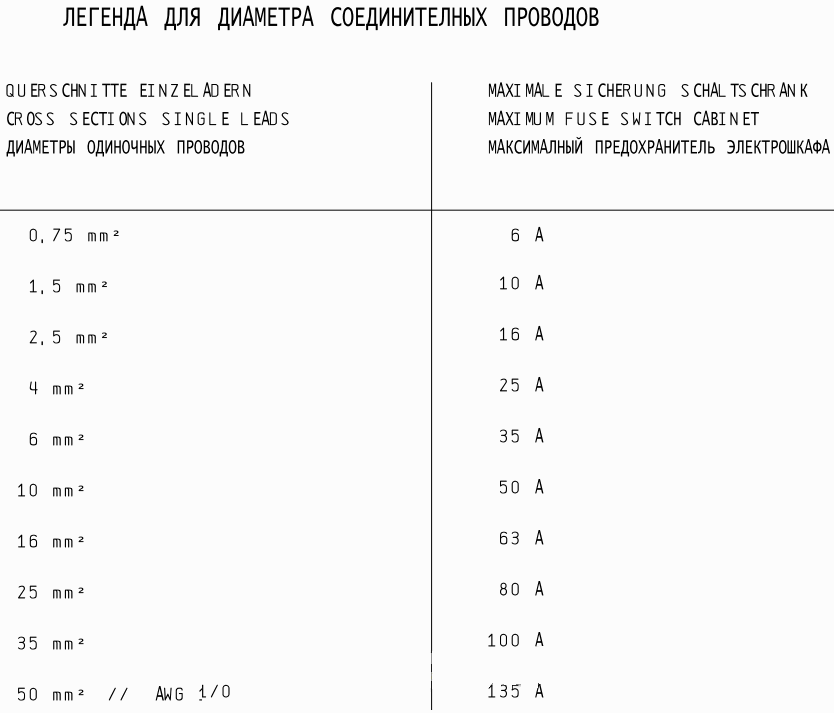
This table is taken from the “strategic” industrial equipment, which may perhaps give the impression that the Germans are reinsured.
In our apartments, the number of sufficiently powerful electrical appliances that have not been used in everyday life is growing. The wiring requirements were not at all the same as they are now. Therefore, the choice of the right power communications requires calculation in each case. Cable cross-section can be calculated by several methods. This indicator should have a sufficient power reserve so that there are no problems during operation, and also the costs were optimal.
In the arrangement of electrical wiring, the choice of cable section plays an important role. It should not be too small so that the wire does not overheat and does not create an emergency. But a too thick cable section will hit the family budget. To make reasonable savings, as well as comply with the requirements of the joint work of electrical engineering, it is simply necessary to carry out calculations. The cross section of the power supply cable is one of the most important indicators.
Calculations must be made for each type of posting. An aluminum core must be thicker than a copper core for the same load. Therefore, it is regulated by the norms that it is copper cable that is used in residential buildings, the cross section of which must be correctly determined. And doing it "by eye" is very wrong and dangerous.
Calculation of the cable cross-section is performed by current, power, length or voltage.
Based on the generally accepted opinion of electricians, which was relevant 20 years ago, people use a very incorrect system when choosing the cable core section.  Once having heard from someone that for lighting a wire requires 1.5 square meters. mm in section, and for wiring - 2.5 square meters. mm, some unscrupulous electricians apply this scheme in all houses, without exception. However, today it is already out of date. It happens that the load on one line will come more than the communications can withstand. In the best case, the wiring will fail. But it happens that the wrong choice of cable cross-section leads to damage to property, and sometimes death. Therefore, an approximate, irresponsible decision when arranging power communications is not only not welcomed, but also strictly prohibited.
Once having heard from someone that for lighting a wire requires 1.5 square meters. mm in section, and for wiring - 2.5 square meters. mm, some unscrupulous electricians apply this scheme in all houses, without exception. However, today it is already out of date. It happens that the load on one line will come more than the communications can withstand. In the best case, the wiring will fail. But it happens that the wrong choice of cable cross-section leads to damage to property, and sometimes death. Therefore, an approximate, irresponsible decision when arranging power communications is not only not welcomed, but also strictly prohibited.
Reasonable margin of safety is the purpose of calculating the cross section of the power cable. 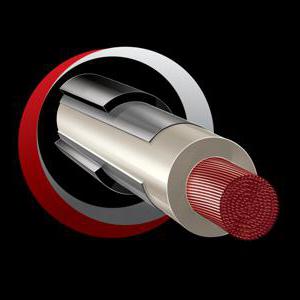
The first thing to start with is to summarize the total electricity consumed by household appliances. This is easy to do by looking at the documentation that came with the purchase. It is also determined which line will have a certain load. It is better not to put all electrical appliances on one outlet. The choice of cable section will be made for each node separately.
Having determined the load attributable to each of them, the conductor cross section is determined by the tables. They are regulated by PUE 1.3.4 - 1.3.11. When purchasing conductors for the network, you should look at their labeling. However, measurements should be made before connecting manually. There are widely known geometric formulas for the area of \u200b\u200ba circle and a rectangle, which allow calculating the cross-section of a cable of an appropriate shape. There are also special calculator programs. With their help, the right choice will be made even easier.
In addition to tables and calculator programs, the determination of the required equipment and electrical communications is done in several ways. 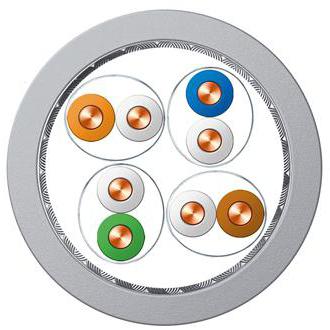
The determination of the cross section, based on the power indicator, will require summing up the individual values \u200b\u200bof each instance of the equipment.
Determining the cable cross-section by current, perform the same procedure. Only the obtained value is divided by the value of the mains voltage. Amperes also correlate with tables.
If the calculation is based on the voltage, then in this case the number of phases is taken into account.
The choice of cross-section along the length is relevant for long-distance communications. The most basic rules electricians will help determine the cross-section of the cable core.
The main wire that leaves the apartment takes on all the load of household appliances. Previously, one power cable was brought into the house. But now the increased requirements for the electric grid suggest dividing the dwelling into several zones. In each of them, the load of all electrical equipment is evenly distributed.  For each line, the total indicator is calculated separately. For example, a kitchen, a corridor, a bathtub and a toilet are in zone 1, and living rooms and a balcony are in zone 2. In the first case, the lighting (300 W), boiler (2000 W), microwave (2000 W), oven will be connected to the cable (3000 W), washing machine (1600 W), coffee maker (1000 W). Together they make up 10 kW. The simultaneity factor is then taken into account. The load will be:
For each line, the total indicator is calculated separately. For example, a kitchen, a corridor, a bathtub and a toilet are in zone 1, and living rooms and a balcony are in zone 2. In the first case, the lighting (300 W), boiler (2000 W), microwave (2000 W), oven will be connected to the cable (3000 W), washing machine (1600 W), coffee maker (1000 W). Together they make up 10 kW. The simultaneity factor is then taken into account. The load will be:
10 * 0.7 \u003d 7 kW.
In the table for the hidden / open type of wiring, according to the obtained value, the cross-section of the copper cable is selected, which in this case is 6 square meters. mm Even for one line, the applied value of 2.5 sq. mm would be extremely insufficient. The second line is calculated by a similar method.
For a large construction site, the cable length should be considered. This is easy to do using the project plan diagram. If not, you can measure the lines manually. Leave a margin for twists and joints of 10 cm on each side. 
The power cable, the cross section of which you want to calculate, inevitably loses its voltage with an increase in length. This property must be taken into account when laying electrical communications over long distances.
If calculations are performed for small apartments, country houses, such errors are allowed to be neglected. Under these conditions, they are not of great importance.
In this case, you should resort to other methods of selecting the cross-section of the conductors.
Another way to select wiring is to determine the current. He will go through communications with a certain strength. The current cross-section of the cable as the basis of calculation is based on the Ohm's law formula. The conductor can easily be represented in the form of a pipe along which the flow moves (in this case, electrons). They move at a certain speed. If the channel is too narrow for them, they will push, it will be crowded. Electrons will begin to exert pressure on the channel, which will begin to overheat. Therefore, the current strength is calculated by summing the power consumption of electrical appliances of the line. Let's say it is 3.8 kW. The current strength will be equal to:
I \u003d P / U * cos φ \u003d 3800/220 * 1 \u003d 17.3 A.
They even resort to the help of the corresponding tables. For hidden copper wiring in this case, a cable section with a safety margin of 2.5 square meters is required. mm
When calculating the network voltage, it should be borne in mind that there are single-phase (220 V) and three-phase (380 V) wiring. 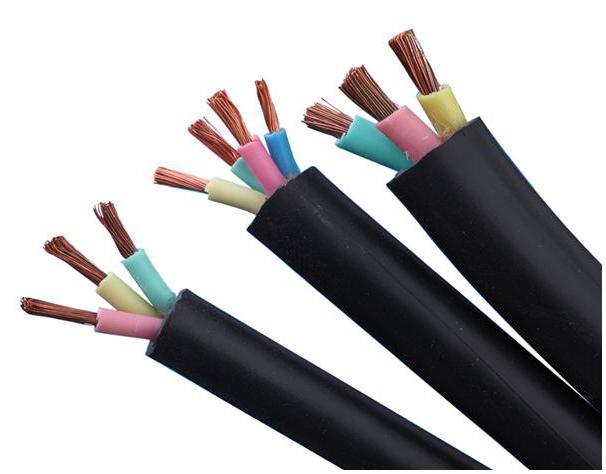
So, if the line load is defined as 20 kW, then in a single-phase power supply network, the entire load will go through it. In three-phase wiring, only 6.6 kW will be applied to each cable. Therefore, for a 220 V network, a larger cable cross section will be required than for a 380 V system.
It should also be noted that for a single-phase type of wiring, a three-core cable is used, and for a three-phase type - a five-wire cable. Reducing the cross section leads to an increase in the number of cores. Therefore, for the calculation, you should determine the type of power grid.
In order not to make a mistake when choosing the correctly calculated section of the conductor in the store, you should never save on quality. If on the counter there are three wires of the same marking, but some of them are much cheaper, you should understand what this is connected with. To reduce the cost of production, the manufacturer saved on insulation quality, copper composition and core thickness.
As a result of this, the safety margin of this cable is significantly less than that of a more expensive but high-quality product. A wire that does not comply with GOST will work to the limit, and it is possible that over time it will cause serious problems. The saved 100 rubles can turn into big trouble.
It is better to measure the diameter of the cross-section yourself and choose proven, responsible manufacturers of electrical communications.
If they were manufactured according to TU, and not according to GOST, with a high degree of probability it can be said that they do not meet the requirements of the wiring power that is required for the conditions of the home.
Having familiarized yourself with such a concept as cable cross-section, you can correctly calculate this indicator and ensure the safe functioning of electrical communications. One of the presented methods will help to carry out the correct calculations.
How to choose a cable to connect household appliances yourself, ensuring the safety of wiring, and without overpaying? What to be guided by when choosing and how to calculate the cable cross section for a group of consumers? You can learn about this from this article.
Cable cross-section is the cross-sectional area of \u200b\u200ba current-carrying core. In most cases, the cable core section is round, and its cross-sectional area can be calculated by the circle area formula. But, given the variety of cable shapes, it is not the linear size that is used to describe its main physical characteristic, but the size of the cross-sectional area. This characteristic is standardized in all countries. In our country, it is regulated by the PUE “Rules for the Installation of Electrical Installations”.
The correct selection of the cable section is, first of all, your safety. If the cable does not withstand the current load, it overheats, melts the insulation, and, as a result, a short circuit and fire can occur.

How to choose the cable of the desired cross section, while avoiding the cases when, when you turn on several devices at the same time, the smell of melting insulation appears, and do not overpay the extra money using wires with a large margin?
For the power supply of residential premises, two main types of cables are used: copper and aluminum. Copper is more expensive than aluminum. But in modern wiring, preference is given to her. Aluminum has a higher internal resistance and is a brittle metal that oxidizes rapidly. Copper is a flexible material, less prone to oxidation. Recently, aluminum cables are used exclusively for the restoration of wiring in buildings of Soviet times.

For preliminary selection of the necessary cross-section of a copper cable, it is generally accepted that a cable with a cross section of 1 mm 2 can pass an electric current through itself of up to 10 A. However, further you will see that this ratio is suitable only for selecting a cross-section “by eye”, and is valid for cross-sections no more than 6 mm 2 (using the proposed ratio, current up to 60 A). An electric cable of such a cross section is enough to enter the phase into a standard three-room apartment.
Most electricians use cables of the following sections to supply electricity to home users:
However, this is acceptable for domestic consumption, provided that each electrical appliance is powered from its outlet, without the use of doubles, tees and extension cords.
When choosing a cable, it will be more correct to use special tables that allow you to choose a section based on the known power of the appliance (kW), or according to the current load (A). The current load in this case is a more important characteristic, since the load in amperes is always indicated on one phase, while for single-phase consumption (220 V) the load in kilowatts will be indicated for one phase, and for three-phase - in total for all three phases.
When selecting the cable section, it is necessary to take into account the type of wiring: external or hidden. This is due to the fact that with hidden wiring, the heat transfer of the wire decreases, as a result of which a more intense heating of the cable occurs. Therefore, for concealed wiring, cables with a cross-sectional area of \u200b\u200babout 30% more are used than with an open one.

Table for choosing the cross-sectional area of \u200b\u200ba copper cable core with open and hidden wiring:
| Cross-sectional area | Open wiring | Hidden wiring | ||||
| S | I | P | I | P | ||
| 220 V | 380 V | 220 V | 380 V | |||
| 0,5 | 11 | 2,4 | - | - | - | - |
| 0,75 | 15 | 3,3 | - | - | - | - |
| 1 | 17 | 3,7 | 6,4 | 14 | 3 | 5,3 |
| 1,5 | 23 | 5 | 8,7 | 15 | 3,3 | 5,7 |
| 2 | 26 | 5,7 | 9,8 | 19 | 4,1 | 7,2 |
| 2,5 | 30 | 6,6 | 11 | 21 | 4,6 | 7,9 |
| 4 | 41 | 9 | 15 | 27 | 5,9 | 10 |
| 5 | 50 | 11 | 19 | 34 | 7,4 | 12 |
| 10 | 80 | 17 | 30 | 50 | 11 | 19 |
| 16 | 100 | 22 | 38 | 80 | 17 | 30 |
| 25 | 140 | 30 | 53 | 100 | 22 | 38 |
| 35 | 170 | 37 | 64 | 135 | 29 | 51 |
Table for selecting the cross-sectional area of \u200b\u200ban aluminum cable core with open and hidden wiring:
| Cross-sectional area | Open wiring | Hidden wiring | ||||
| S | I | P | I | P | ||
| 220 V | 380 V | 220 V | 380 V | |||
| 2 | 21 | 4,6 | 7,9 | 14 | 3 | 5,3 |
| 2,5 | 24 | 5,2 | 9,1 | 16 | 3,5 | 6 |
| 4 | 32 | 7 | 12 | 21 | 4,6 | 7,9 |
| 5 | 39 | 8,5 | 14 | 26 | 5,7 | 9,8 |
| 10 | 60 | 13 | 22 | 38 | 8,3 | 14 |
| 16 | 75 | 16 | 28 | 55 | 12 | 20 |
| 25 | 105 | 23 | 39 | 65 | 14 | 24 |
| 35 | 130 | 28 | 49 | 75 | 16 | 28 |
S - cable cross-sectional area (mm 2), - total power of electrical equipment (kW).
It is also necessary to make adjustments when selecting the cable cross-section, taking into account its length. To do this, having selected the cable section from the table by current strength, we calculate its resistance taking into account the length according to the formula:
R \u003d p ⋅ L / S
Using this formula, you can get the resistance of one core of the cable. Since the current comes in one core, and returns in another, in order to get the cable resistance value, it is necessary to multiply the resistance of its core by two:
dU \u003d I ⋅ R total
If the cable section was selected according to the total power of the equipment and the current strength is not known, it can be calculated by the formula:
for single-phase network (220 V): I \u003d P / U ⋅ cos φ
for a three-phase network (380 V): I \u003d P / 1,732 ⋅ U ⋅ cos φ
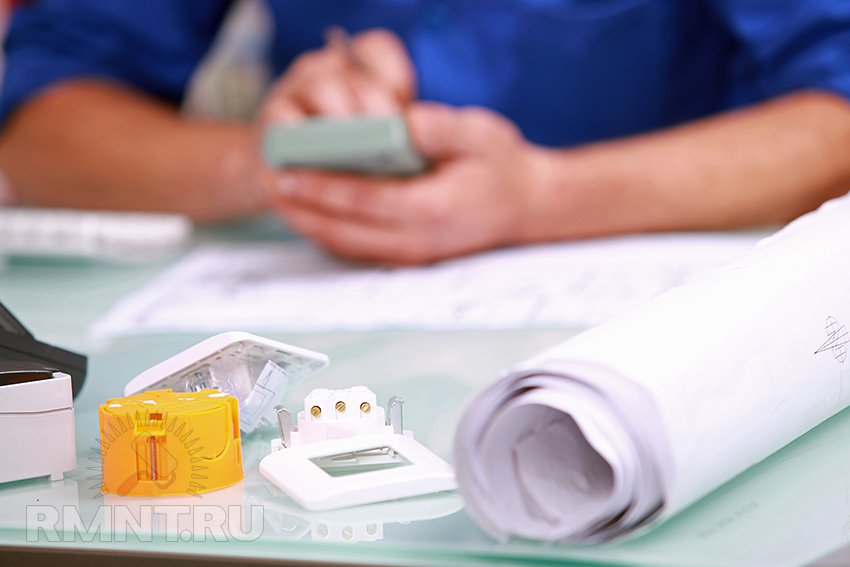
If the obtained value does not exceed 5%, then the cable cross-section, taking into account its length, is chosen correctly. If it exceeds, it is necessary to select a cable with a larger cross section (the next in a row) from the table and calculate again.
These tables are applicable for cables in rubber and plastic insulation, the cable selected according to them cross-section will work efficiently if it is produced according to GOST.
To select the cable section for a group of consumers (for example, an input cable to the apartment), you can use the formula to determine the permissible current load. We calculate the current load for a 220 V network, which is often used in domestic power supply:
I \u003d P ⋅ K / U ⋅ cos φ
Having calculated the permissible current load for a group of consumers, it is possible, using the tables above, to select the cable of the required cross section. If a long simultaneous inclusion of all possible consumers (for example, electric heating) is assumed, the calculation of the permissible current load must be carried out without taking into account the coefficient K.
Based on the foregoing, we will try to calculate and select a copper cable of the necessary cross section for a single-phase electric boiler, with a heating element with a power of 2.0 kW, provided that the cable is laid to it in the box. The cable length will be 10 meters.
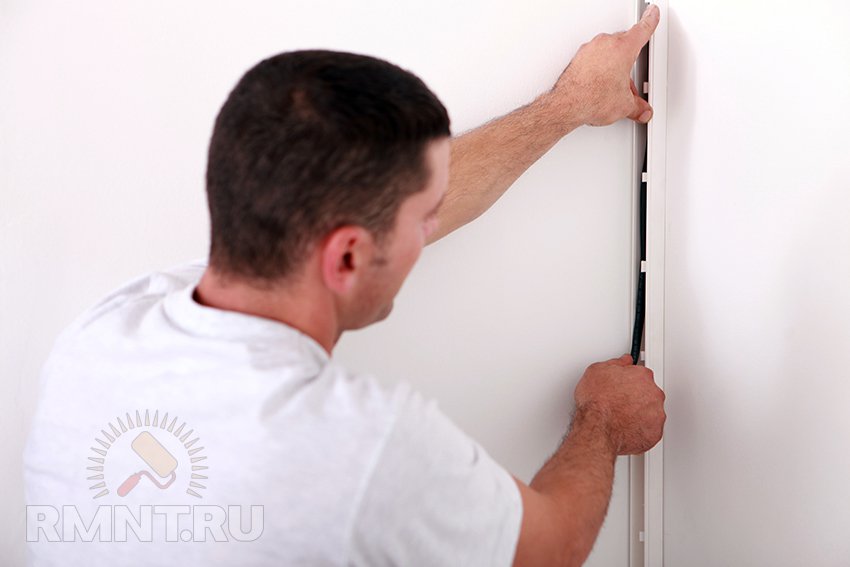
The table shows that close in power is the value of 3.0 kW, which corresponds to the cross-sectional value of the cable 1 mm 2. Let's calculate taking into account the cable length.
We calculate the current strength: I \u003d 2000 W / 220 V ⋅ 1 \u003d 9.09 A.
We calculate the resistance of the cable core: R \u003d 0.0175 Ohm⋅mm 2 / m ⋅ 10 m / 1 mm 2 \u003d 0.175 Ohm.
Total cable resistance: R total \u003d 2 ⋅ R \u003d 0.35 Ohm.
We calculate the voltage loss: dU \u003d 9.09 A ⋅ 0.35 Ohm \u003d 3.18 V.
We calculate the loss as a percentage: (3.18 V / 220 V) ⋅ 100% \u003d 1.45% (does not exceed 5%).
A cable with a cross section of 1 mm 2 is suitable for connecting the electric boiler indicated in the example.
Often manufacturers in the equipment manual indicate the required cable cross-sectional area for their equipment. If there is such an indication, it must be followed.
Alexander Krivitsky, rmnt.ru